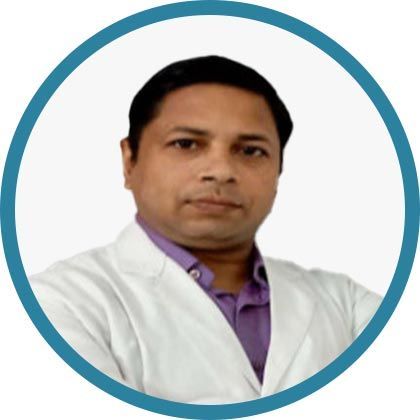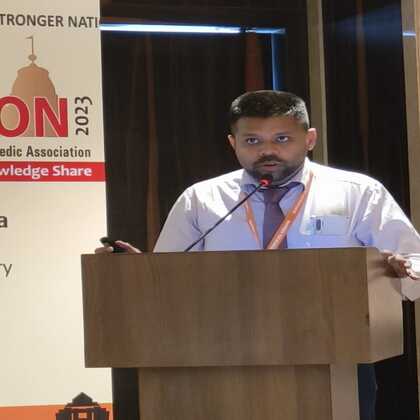Avascular Necrosis: Causes & Treatment
Learn about Avascular Necrosis (AVN), its causes, symptoms, stages, and treatment options. Discover effective non-surgical and surgical approaches to manage AVN.

Written by
Last updated on 3rd Jul, 2025
Avascular Necrosis (AVN), also known as osteonecrosis, is a serious condition that occurs when the blood supply to a bone is disrupted, leading to bone tissue death. This condition primarily affects the joints, such as the hip, knee, shoulder, and ankle, but it can occur in any bone. As AVN progresses, the affected bone begins to collapse, causing severe joint pain and disability if untreated. Bone health plays a vital role in maintaining mobility and overall well-being, making it crucial to understand and address AVN promptly.
Causes of Avascular Necrosis
Common Risk Factors and Underlying Conditions
Avascular Necrosis often stems from conditions that affect the body's ability to deliver adequate blood flow to the bones. Key risk factors include:
Excessive alcohol consumption: Long-term alcohol use can cause fatty deposits in the blood vessels, obstructing blood flow.
Corticosteroid use: Prolonged use of corticosteroids, often prescribed for autoimmune conditions, can lead to AVN.
Autoimmune disorders: Diseases like lupus or rheumatoid arthritis may predispose individuals to AVN by damaging blood vessels or causing inflammation.
Impact of Trauma and Injury
Injuries such as fractures, dislocations, or blunt trauma can directly compromise the blood vessels supplying the bone. Without sufficient blood flow, the bone tissue gradually deteriorates, resulting in necrosis.
Pathophysiology of Avascular Necrosis
Disruption of Blood Supply to the Bone
Blood supply is essential for maintaining bone vitality. In AVN, an obstruction (caused by a clot, trauma, or other factors) leads to oxygen and nutrient deprivation in the bone tissue.
Cellular Changes and Bone Collapse
Without blood flow, bone cells begin to die. Over time, the bone structure weakens, leading to its collapse. Surrounding cartilage may also deteriorate, causing severe joint damage.
Symptoms and Diagnosis
Early Signs and Progressive Symptoms
AVN symptoms vary depending on the affected bone and stage of progression.
Early symptoms: Dull or mild pain in the joint, stiffness, or discomfort during movement.
Progressive symptoms: Increased pain during weight-bearing activities, restricted joint movement, and eventual disability.
Consult Top Doctors For AVN Symptoms
Diagnostic Imaging and Tests
Diagnosis often involves:
X-rays: To identify bone changes in later stages.
MRI scans: To detect AVN in its early stages by visualising blood flow and bone damage.
Bone scans: Useful in locating areas of reduced blood flow.
Stages of Avascular Necrosis
Ficat and Arlet Classification Stages
AVN progression is commonly categorised using the Ficat and Arlet classification:
Stage I: Normal X-rays, but MRI reveals blood flow issues.
Stage II: Visible bone sclerosis or cysts on imaging.
Stage III: Collapsed bone structure and damaged cartilage.
Stage IV: Severe joint damage, arthritis, and loss of function.
Prognosis for Each Stage
Early-stage AVN has a better prognosis with timely treatment. Advanced stages often require surgical intervention, and long-term outcomes depend on the extent of joint damage.
Non-Surgical Treatments
Medications to Manage Pain and Progression
Pain relievers: Nonsteroidal Anti-Inflammatory Drugs (NSAIDs) like ibuprofen can ease discomfort.
Bisphosphonates: These medications help slow bone loss and maintain bone density.
Anticoagulants: For patients with clotting disorders, these drugs improve blood flow to the bones.
Lifestyle and Activity Modifications
Weight management: Reducing body weight alleviates stress on affected joints.
Low-impact activities: Swimming or cycling minimises strain while maintaining mobility.
Avoiding smoking and alcohol: Both impede blood circulation, exacerbating AVN progression.
Surgical Treatment Options
Core Decompression and Bone Grafts
Core decompression: Surgeons remove a portion of the inner bone to relieve pressure and stimulate blood flow.
Bone grafts: Healthy bone tissue is transplanted to support the damaged area and promote regeneration.
Total Joint Replacement
In advanced cases, total joint replacement surgery may be necessary to restore mobility and relieve pain. This procedure involves replacing the damaged joint with an artificial implant.
Rehabilitation and Recovery
Physical Therapy and Exercises
After treatment, physical therapy plays a crucial role in restoring joint function and muscle strength. Tailored exercises improve the range of motion and support recovery.
Expected Recovery Timeline
Recovery varies based on the severity of AVN and treatment type. Non-surgical treatments may take months, while surgical recovery can range from a few weeks to several months.
Living with Avascular Necrosis
Coping Strategies and Support Systems
Mental health: Coping with chronic pain and mobility challenges may require emotional support or counselling.
Support groups: Connecting with others who have AVN can provide encouragement and practical advice.
Long-Term Outlook and Quality of Life
With early diagnosis and appropriate treatment, many individuals with AVN can lead active and fulfilling lives. Adopting healthy lifestyle habits and following medical recommendations ensures better outcomes.
Conclusion
Avascular Necrosis is a debilitating condition that requires prompt attention and comprehensive care. Understanding its causes, stages, and treatment options can help patients and caregivers navigate this challenging condition effectively. Whether through medication, lifestyle changes, or surgery, the goal is to restore mobility, alleviate pain, and improve overall quality of life. If you suspect AVN, consult a healthcare professional for timely diagnosis and tailored treatment options.
Consult Top Orthopaedicians
Consult Top Orthopaedicians
Dr. Anil Sharma
Orthopaedician
42 Years • MBBS, MS Orthopedics
New Delhi
AAKASH MEDSQUARE, New Delhi

Dr. Sourav Kumar Pal
Orthopaedician
3 Years • MBBS, MS(ORTHO)
Malda
B S ORTHO, Malda

Dr. Pradeep Lucas
Orthopaedician
7 Years • MBBS, Diploma in Orthopaedics, Fellowship in DFSI
Bengaluru
Revival Multispeciality Clinic, Bengaluru

Dr. Manoj Dinkar
Orthopaedician
15 Years • MBBS, Dip (Orthopaedics)
New Delhi
THE DOCTORS NESST, New Delhi

Dr. Mriganka Ghosh
Orthopaedician
11 Years • MD (Physician), DNB (Orthopaedics)
Howrah
Dr Mriganka Mouli Ghosh, Howrah
Consult Top Doctors For AVN Symptoms
Dr. Anil Sharma
Orthopaedician
42 Years • MBBS, MS Orthopedics
New Delhi
AAKASH MEDSQUARE, New Delhi

Dr. Sourav Kumar Pal
Orthopaedician
3 Years • MBBS, MS(ORTHO)
Malda
B S ORTHO, Malda

Dr. Pradeep Lucas
Orthopaedician
7 Years • MBBS, Diploma in Orthopaedics, Fellowship in DFSI
Bengaluru
Revival Multispeciality Clinic, Bengaluru

Dr. Manoj Dinkar
Orthopaedician
15 Years • MBBS, Dip (Orthopaedics)
New Delhi
THE DOCTORS NESST, New Delhi

Dr. Mriganka Ghosh
Orthopaedician
11 Years • MD (Physician), DNB (Orthopaedics)
Howrah
Dr Mriganka Mouli Ghosh, Howrah
